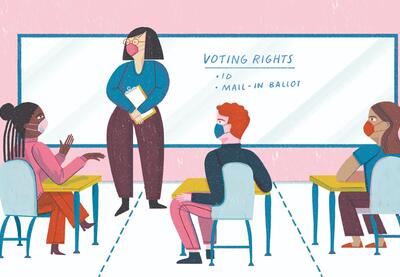This “Teach This” discussion guide centers an excerpt from Carol Anderson’s One Person, No Vote, adapted for young adult readers by Tonya Bolden. Pairing this excerpt with a short video about Black political power during Reconstruction can help students understand how voter suppression strategies like literacy tests and other elements of the “Mississippi Plan” worked to roll back rights that Black men had already secured. It helps lay the groundwork for the need for the Voting Rights Act of 1965. And it offers an opportunity to discuss voter suppression on the interpersonal and systemic levels.
Here’s how you might start.
1. Check Your Students’ Previous Knowledge
To set the stage for understanding how voting rights have expanded and contracted in the United States, have students review TT’s Voting Rights Timeline. Have students look at the first century of U.S. history, from 1776 to 1870. Ask them to consider: Whose rights were expanded over this century? Who lost the right to vote? Encourage them to consider why this might be the case.
A note on teaching through a pandemic:
We recognize that not all educators will be sharing physical or virtual space with students this fall. Because of that, we’ve tried to design these discussion guides in ways that can easily work across classes, whether you’re meeting face to face, in a virtual classroom or through another remote learning schedule. We’re so grateful to you and all the educators doing extraordinary work in these extraordinary times.
To help students understand the context of Reconstruction, share the two-minute video Reconstruction: The Vote. The video introduces students to the ways that Black men gained political agency in the South following the Civil War—agency that laws like literacy tests and poll taxes aimed to destroy. Encourage students to focus on the scope of Black political power during Reconstruction by asking them to note the answers to the following questions as they watch: What percent of Black men living in former Confederate states were registered to vote in 1867? Including all levels of government, how many Black men held office during Reconstruction?
2. Read Together and Clarify Understanding
Read the excerpt “Voter Suppression and Literacy Tests” from One Person, No Vote: How Not All Voters Are Treated Equally, by Carol Anderson with Tonya Bolden. Please note that one quotation within this excerpt includes a racial slur—prepare ahead to let students know that the excerpt includes several racist quotes and to ensure slurs aren’t read aloud in your class.
If students are working asynchronously, you may want to provide these questions to help them focus their learning as they read. If you’re meeting with students, try having them work individually, in pairs or in a group to answer a few text-dependent questions. For example:
- What is a “literacy test”? What is an “understanding clause”? How were “understanding clauses” used?
- Anderson and Bolden quote some lawmakers who were quite proud to enact racist laws. Other lawmakers, they say, “pitched” laws that were “racially discriminatory” in a different way. How did Southern lawmakers at the time justify racist policies like the “Mississippi Plan”?
- According to Virginia state Senator Carter Glass, what was the purpose of the state’s 1901-02 Constitutional Convention? What was his goal at that convention?
- What document did Black Mississippians have to read and explain a part of (or explain after hearing it read aloud to them) in order to vote before the Voting Rights Act of 1965?
3. Talk Together
The following questions can help students process their understanding of this history and consider how they might connect it to their experience and understanding of elections and voter suppression.
- The excerpt includes statements from racist Southern politicians including Carter Glass, Theodore Bilbo and James Zachariah George in which they brag about the ways they have disenfranchised Black voters. Why do you think Anderson and Bolden chose to include these quotations?
- We know that many white people were allowed to vote in the South. How could elections officials help white men get around voter suppression tactics like having to explain a section of the state constitution?
- Did you try to read the sample passage from the Alabama state constitution included in the excerpt? Do you think most people today could understand that passage and explain its meaning if it were read to them? Why or why not?
- In the excerpt, Anderson connects literacy tests with a lack of school funding. What argument does she make? What do you think of this argument?
- Near the end of the video, Professor Khalil Gibran Muhammad explains that when Congressman White, the last Black congressman elected during Reconstruction, ended his term, “he literally turn[ed] the light off on national Black political leadership ... for an entire generation.” What are some ways the United States might be different today if Black voters in the South hadn’t been disenfranchised and that generation of Black leaders had been included in decision-making for the nation?
- At the close of “Reconstruction: The Vote,” Professor Henry Louis Gates suggests that one of the important lessons of Reconstruction is that “achievements thought permanent can be overturned, and rights can never be taken for granted.” What does it look like to take our rights for granted? What does it look like to do the opposite?
For additional discussion guides, recommended lesson plans, PD and more, check out TT’s Future Voters Project.
